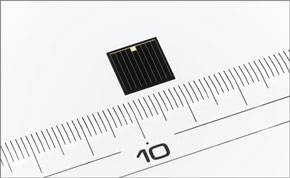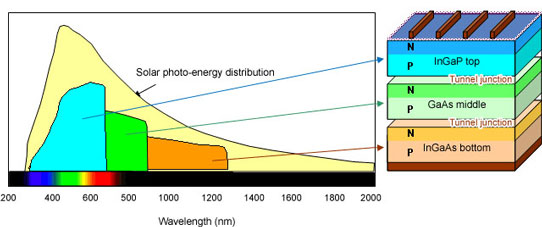- News
10 December 2012
Sharp claims record 37.7% efficiency for non-concentrator solar cell
Japan’s Sharp Corp has achieved what is claimed to be record solar cell conversion efficiency (for research-level non-concentrator solar cells) of 37.7% using a triple-junction III-V compound semiconductor solar cell (in which three photo-absorption layers are stacked together) with a cell surface of about 1 cm2.
 Picture: Triple-junction cell with record efficiency of 37.7%.
Picture: Triple-junction cell with record efficiency of 37.7%.
Sharp says that it achieved the breakthrough as a result of an R&D initiative promoted by Japan’s New Energy and Industrial Technology Development Organization (NEDO) on the theme of ‘R&D on Innovative Solar Cells’ (in which Sharp has previously achieved triple-junction cell efficiency of 35.8% in 2009 and 36.9% in 2011, as well as 43.5% for a concentrator triple-junction cell, at 360-fold concentration, in June 2012). Measurement of the value of 37.7% was confirmed in September by Japan’s National Institute of Advanced Industrial Science and Technology (AIST).
The basic structure of the latest triple-junction compound solar cell uses proprietary Sharp technology that enables efficient stacking of the three photo-absorption layers, with an InGaP (indium gallium phosphide) top layer, GaAs (gallium arsenide) middle layer and InGaAs (indium gallium arsenide) bottom layer, separated by tunnel junctions.

Graphic: Wavelength distribution of solar photo-energy and wavelength sensitivity of triple-junction cell for the InGaP, GaAs and InGaAs parts of the structure.
To achieve the latest increase in efficiency, Sharp capitalized on the new cell’s ability to efficiently absorb light from different wavelengths. Sharp also increased the active area (the ratio of the effective light-reception area to the total surface area of the cell) for converting light into electricity through optimal processing of the cell edges. These improvements led to higher maximum output levels for the solar cell and enabled Sharp to achieve the 37.7% efficiency.
Sharp’s aim for the future is to apply the latest development to concentrator photovoltaic (CPV) power systems that use lenses to collect and convert sunlight into electricity. The firm also foresees many other practical applications for the cells, such as on space satellites and vehicles.
Sharp Triple-junction solar cell


